- Bernard Preston homepage
- Greens
- How to Make Kale Pesto
How to make kale pesto
How to make kale pesto can be a ten-minute job if you're like Jack; nimble and quick. Should the family eat this regularly it will go a long way to saving them all from the dreaded misery that is macular degeneration; glaucoma and cataracts too.
That's easy to say but just read the convincing research lower down.
It's also the cure for that other misery; chronic constipation. Only 5% of folk eating typical grocery store food get the recommended daily allowance of fibre; but too much of a good thing may give you diarrhoea.
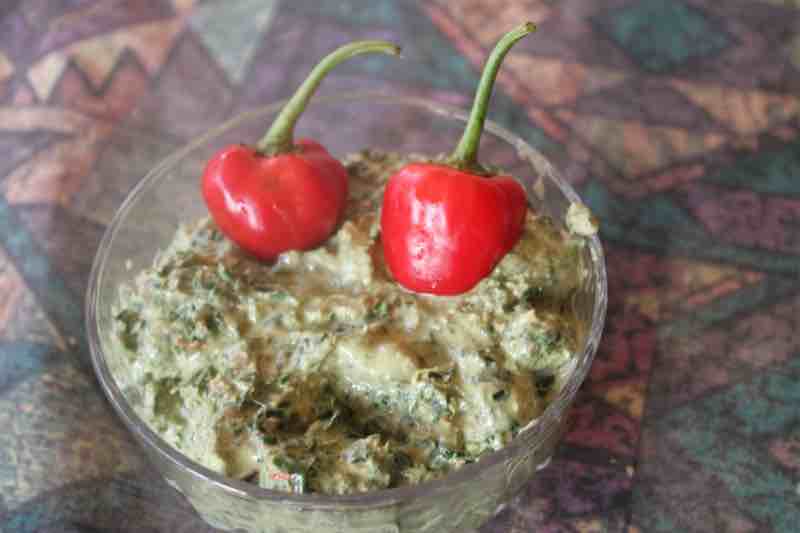
Pesto is traditionally made with sweet-basil and pine nuts. Today we do something different. It is just as tasty but has rather other benefits; both are good.
Ingredients
- Two large bunches of young-kale leaves
- 2 TBSP freshly-cracked pecan nuts
- 1/4 cup grated Parmesan or other cheese
- 1 clove of garlic
- 1 peppadew or slither of chili
- 1 good slosh of extra virgin olive-oil
- 1 segment of whole lemon or lime
Go for it
- Strip the kale-leaves from the stalks.
- Drop them into boiling-water for 2 minutes.
- Drain and pop into a tall container.
- Add the garlic, peppadew and olive-oil.
- Now the cheese, lemon and nuts.
- Blend but not too smooth.
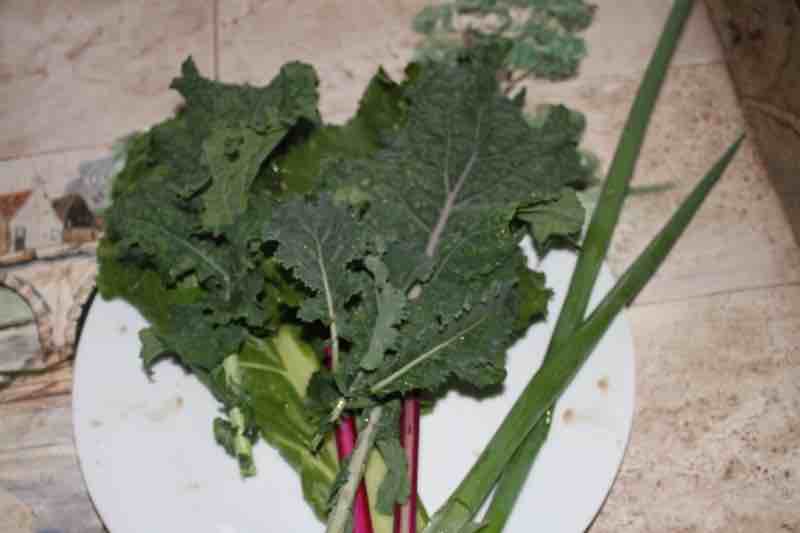
If you have very young kale then you can certainly bypass cooking them which really is the more traditional way. But that's unlikely unless you grow the plants yourself. By all means drop in a few sweet basil leaves, spinach or beet-tops too.
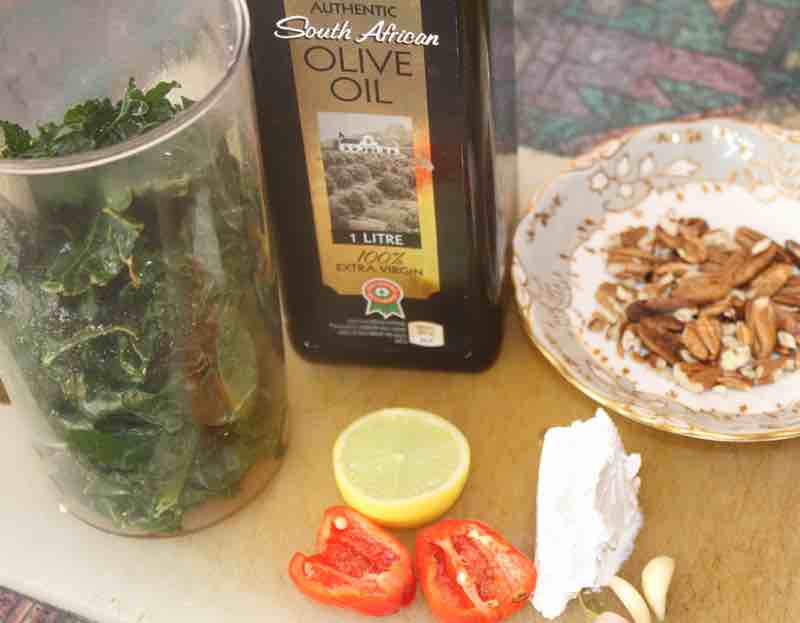
Better still use many different kinds of kale; we have five growing in Our Green Garden.
I make no apology for freshly-cracked nuts. Yes, it will take you five or ten minutes. Once that shell is broken and oxygen gets to the oils they start to go rancid. You know, that horrid smell when you open a packet from the shop.
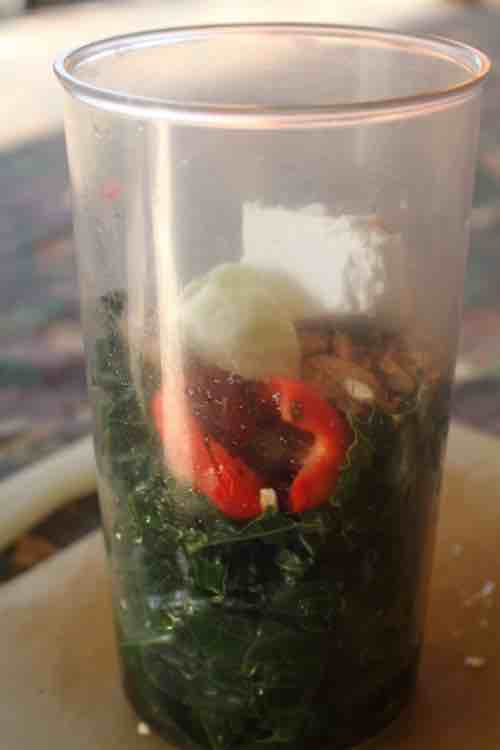
We push hard to eat at least ten different coloured foods every day simply because the research is so strong that they dramatically reduce the all-cause of death. The quantity is not important, so just a sprig of parsley would count for one.
In our kale pesto there are five different varieties, not all seen in the photo; I have also added a leaf of spinach and another beet-top. There are nuts, peppadews and lemon pulp; it is not onerous to achieve ten coloured foods in a day.
Lutein
Dark-green leafy vegetables are so important for many reasons, not least a carotenoid called lutein; it is transported exclusively to the retina of the eye where it absorbes the damaging high energy photons of light. Talk to anyone with Macular Degeneration and you'll find they are on a prescription for it; too late, cried he. Prevention remains for ever better than a cure.
Over five million Americans are needlessly blind and many more are partially sighted because they abhor dark-green leafy vegetables[1]. Lutein helps prevent cataracts and glaucoma too.
"Greater carotenoid levels in the macular pigment were largely associated with improved visual performance in glaucomatous eyes."
- Nutrients. June, 2021
Other phytochemicals are necessary too in the prevention of adult-onset macular degeneration, the most common cause of blindness in the elderly; notably zeaxanthin[2] and the oleocanthal found only in extra virgin olive oil.
Vitamin E[3] and omega 3 fatty acids[4] are important too; freshly-cracked nuts are good sources.
The "happy hormone" dopamine is also important for the eyes; read lower down about how fava beans can provide this nutrient.
Making a probiotic such as sauerkraut or kefir has a high priority at our green home for happy tums[6]. The friendly bugs in the colon are important sources of dopamine.
Your kale pesto is to my mind just one of dozens of condiments such as hummus or this lentil dish that can make a green salad rather more interesting.
And of course use as many different coloured-vegetables as possible; tomatoes, orange peppers and grated beets all add not only to the nutrition but to create an attractive meal too.
In broad bean season this kale pesto goes particularly well with our favourite legume; it's interesting that, quite independently, all those living in the five Blue Zones[7] of the world, where longevity is the key-word, grow and eat them. They are also known as favas.
Usually you will find that olive oil and lemon are amongst the chief ingredients; added to your kale pesto, they turn it into a veritable medicine-chest of prevention. One of these nutrients is sulforaphane for diabetics.
Lemon juice
I almost never use lemon juice; that's odd I hear you thinking. It is because more than half of the goodies are found in the pulp.
So lemon pulp is used in our cooking every single day. Citrus is the richest source of vitamin C and a very interesting phytonutrient called limonin[5]. Few conditions frighten me more than Alzheimer's disease; so bad is the typical grocery store diet that one in nine Americans over 65 are already suffering[9]. That is terrifying.
Citrus in general is the best source of beta-cryptoxanthin; the most important phytonutrient in the fight against senility.
Learning how to make kale pesto is not "small beer" as grandpa used to say.
Nuts and seeds
Nuts, seeds and whole grains too are rich sources of very important phytonutrients called lignans; they protect women from malignant breast tumours and all of us from cardiovascular disease.
What are lignans explains this complex subject for the layperson; nuts, seeds and whole grains all have a place in our top 7 functional foods for optimal health[8].
Find a place for them in your condiments; learning how to make kale pesto is profoundly important for our wellness.
Parkinson's Disease
There is strong research confirming that both acquiring Parkinson's Disease and how fast it progresses is related to our food. Meals rich in the carotenoids in which lutein gets a special mention inhibit the onset of the motor symptoms of the condition. Fava beans are the only source of pharmaceutical amounts of dietary L-dopa; over 60% of those with PD would be better off eating them than taking the medicine.
So too the presence of a rich and diverse microbiome in the gut is important; that means more dietary fibre. Don't skin your fava beans.
Your kale pesto is a particularly rich source of both lutein and fibre. Prevention is better than a cure is often trotted out but then completely ignored to all intents and purposes.
French onion and blue cheese wholegrain quiche
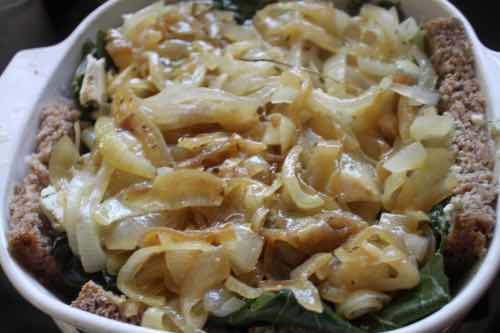 The kale lurks unseen beneath
The kale lurks unseen beneathYou really have to dicky up some very important foods that are lack-lustre; kale is one of them. Bake this French onion and blue cheese wholegrain quiche for a low GI dinner in a jiffy. You could use spinach.
How to make kale pesto
How to make kale pesto is for the well-being of many parts of the body but especially the eyes and the nerves.
- Lutein and Macular Degeneration from the National Eye Institute.
- Zeaxanthin macular degeneration. Web: shorturl.at/sxHY2
- Frailty and vitamin E
- Anti-inflammatory omega 3
- Limonin protection against the neurodegenerative-diseases.
- The happy tum
- Blue zone longevity
- Top 7 functional foods for your health
- Alzheimer's Disease; facts and figures
When browsing use right click and Open Link in New Tab, or you may get a bad gateway signal.
Newsletter
Our newsletter is entitled "create a cyan zone" at your home, preserving both yourself and Mother Earth for future generations; and the family too, of course. We promise not to spam you with daily emails promoting various products. You may get an occasional nudge to buy one of my books.
Here are the back issues.
- Lifestyle and ideal body weight
- What are ultra-processed foods?
- Investing in long-term health
- Diseases from plastic exposure
- Intensive lifestyle management for obesity has limited value
- A world largely devoid of Parkinson's Disease
- The impact of friendly bacteria in the tum on the prevention of cancer
- There's a hole in the bucket
- Everyone is talking about weight loss drugs
- Pull the sweet tooth
- If you suffer from heartburn plant a susu
- Refined maize meal and stunting
- Should agriculture and industry get priority for water and electricity?
- Nature is calling
- Mill your own flour
- Bake your own sourdough bread
- Microplastics from our water
- Alternative types of water storage
- Wear your clothes out
- Comfort foods
- Create a bee-friendly environment
- Go to bed slightly hungry
- Keep bees
- Blue zone folk are religious
- Reduce plastic waste
- Family is important
- What can go in compost?
- Grow broad beans for longevity
- Harvest and store sunshine
- Blue zone exercise
- Harvest and store your rainwater
- Create a cyan zone at your home
Did you find this page interesting? How about forwarding it to a friendly book or food junkie? Better still, a social media tick would help.
- Bernard Preston homepage
- Greens
- How to Make Kale Pesto
Address:
56 Groenekloof Rd,
Hilton, KZN
South Africa
Website:
https://www.bernard-preston.com